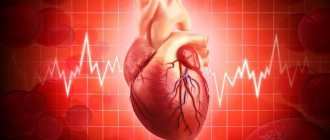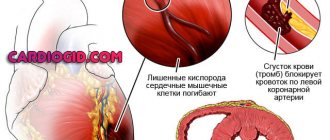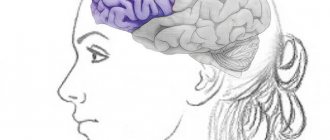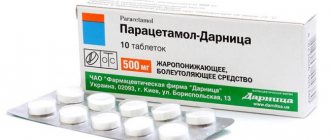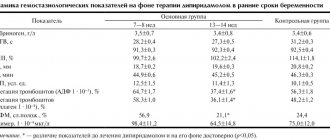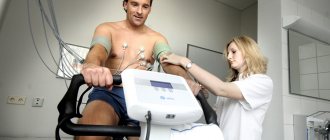Blood pressure is the rate of blood flow through large arteries in the human body, measured in mmHg.
It is divided into two types: diastolic (upper) and systolic (lower). Based on the upper indicator, the pressure of relaxed arteries is determined, and the first criterion depends on the speed of heart contractions. When calculating from systolic blood pressure to distolic blood pressure, pulse pressure is obtained. In adolescents, blood pressure should be about 110*70, in adults under 60 years old 125*85, in elderly people 135*90 mmHg. Art.
Within one day, the human body can experience sudden changes in pressure, which affects its overall well-being. With an increase in the indicator for every 10 mm Hg. the risk of heart and vascular diseases increases.
Content:
- What is hypotension?
- Low blood pressure - causes
- Low blood pressure - symptoms?
Arterial pressure
– the main indicator of hemodynamics, which determines the speed and volume of blood flow in all tissues. The condition refers to polyetiological pathological processes. This means that it develops due to the influence of several causes. Clinical symptoms include manifestations of hemodynamic disturbances with oxygen starvation of tissues.
Causes of nausea when pressure changes
Nausea does not always indicate a serious health problem. The cause of the condition may be toxicosis in a pregnant woman, poisoning with low-quality products, motion sickness after traveling in transport, or anemia. But if the problem recurs regularly and is accompanied by an increase or decrease in blood pressure (blood pressure), it is worth undergoing an examination and understanding the root cause of the disorder. The diagnosis and treatment regimen for this condition depend on the pressure at which you feel sick.
Most often, experienced hypertensive patients experience nausea, accompanied by vomiting, headache and tinnitus. The more severe the stage of the disease, the more pronounced these symptoms are when blood pressure jumps. When blood circulation in the brain is impaired, the vomiting center is irritated, and an adult or child begins to feel sick and vomiting appears.
Nausea with high blood pressure is most often caused by the approach of a hypertensive crisis. The person begins to panic, this leads to the release of cortisol and adrenaline, which provoke the growth of cerebrospinal fluid. Against this background, intracranial pressure increases, and there is a risk of cerebral hemorrhage. The body tries to cope with the serious condition by increasing urination and vomiting begins.
Additional symptoms of the disorder include lethargy, redness of the face and neck, and numbness of the extremities. If high blood pressure develops into a stroke, then nausea is accompanied by slow speech, deviation of the tongue when protruding to the side, dizziness, and severe headache.
Both in case of a stroke and a hypertensive crisis, it is important to seek qualified medical help as quickly as possible
Nausea with low blood pressure may indicate physical or nervous exhaustion or meteosensitivity. The symptoms are caused by strict diets, lack of sleep, stress, and lack of vitamins and microelements in the diet. But things don't always turn out to be so harmless. A feeling of nausea with low blood pressure may be a manifestation of internal bleeding and pathologies of internal organs. This symptom is also characteristic of true hypotension.
What is hypotension?
The term arterial hypotension (hypotension) defines a decrease in blood pressure. This is not a separate disease, but a syndrome that develops as a result of exposure to various provoking factors or against the background of diseases. A decrease in the indicator leads to a decrease in the volume and speed of blood flow in peripheral tissues. First of all, the cells of the nervous system, which are very sensitive to energy and oxygen starvation, are affected.
Low blood pressure - causes
Arterial hypotension develops due to exposure to a large number of pathological or physiological causes. The most common ones include:
- Poisoning of the body
– ingestion of various toxins from the outside with food, inhaled air, or intoxication due to the development of an infectious process.
- Violation of the regulatory influence of nervous system structures
on arterial vessels, leading to a sharp decrease in the tone of their walls - cerebral stroke, organic changes, infectious processes in the structures of the central nervous system, previous traumatic brain injuries, functional disorders of various origins.
- Dilatation of arteries against the background of decreased tone of the whole body
, which occurs against the background of physical and mental fatigue, lack of sleep, poor nutrition, hypovitaminosis (hypovitaminosis is an insufficient supply of one or more vitamins to the body).
- Decrease in circulating blood volume due to blood loss
(internal or external hemorrhage) or dehydration (loss of fluid due to uncontrollable diarrhea, vomiting, insufficient water intake).
- Severe allergic reactions
, accompanied by a pronounced decrease in arterial tone - anaphylactic shock.
- Changes in hormone levels in the blood
, which have a regulating effect on arterial tone, heart rate, blood pressure and other hemodynamic indicators - adrenaline, hormones of the adrenal cortex, pituitary gland influence the course of a large number of physiological processes in the body.
- Redistribution of fluid in the body
with a transition from the vascular bed to the intercellular substance of tissues, which leads to a decrease in the volume of circulating blood with arterial hypotension.
- Weakening of the contractile function of the heart
, provoked by pathological processes in the myocardium - infarction, myocardiopathy, myocarditis.
- Violation of the rhythm and frequency of heart contractions
, caused by various pathological factors and leading to a decrease in blood pressure.
A decrease in the level of systemic blood pressure is a consequence of pathological processes in other organs, in particular with diabetes mellitus, hepatitis, and anemia. Physiological arterial hypotension develops during the period of adaptation of the human body to a reduced concentration of oxygen in the inhaled air (stay in high mountain areas). Causes of low blood pressure in women include the effects of hormonal changes during menstruation, early pregnancy, and menopause (age-related decline in reproductive function).
Low blood pressure - symptoms?
Arterial hypotension is accompanied by a violation of the functional state of various organs and systems, which develops against the background of energy and oxygen starvation. Symptoms of low blood pressure include the following:
- General weakness
– a constant symptom of hypotension, the severity of which depends on the degree of decrease in blood pressure.
- Dizziness
– the result of oxygen starvation of neurocytes.
- Memory impairment, decreased mental performance
– low blood pressure affects a person’s higher nervous activity; signs usually appear with prolonged moderate hypotension, as well as against the background of the development of anemia.
- Paleness of the skin and visible mucous membranes
– the sign appears in cases where arterial hypotension develops sharply and is accompanied by a decrease in circulating blood volume (after bleeding).
- Headache
, which is predominantly localized in the temples, crown and can have varying severity.
With severe hypotension, a person loses consciousness, which is associated with oxygen starvation of the cerebral cortex. If systolic pressure is below 70 mm Hg. Art. acute renal failure develops, decompensation of the functions of all organs, which becomes the cause of death.
To understand why a particular patient has low blood pressure, a doctor (general practitioner, family doctor, cardiologist) must prescribe an additional objective examination. It includes various techniques, namely clinical blood tests, urine tests, ECG, X-rays, computed tomography, magnetic resonance imaging. Based on a thorough and reliable diagnosis, the correct treatment is prescribed.
Signs and consequences of increased blood pressure
Not every person knows his individual blood pressure when he feels normal. But what consequences can occur when blood pressure rises? In medical practice, pathology associated with high blood pressure is called hypertension. This disease manifests itself differently in people of different ages.
Specialists at the Carnelian Medical Center in Novosibirsk noted the main symptoms of high blood pressure:
- regular feeling of coldness in the lower extremities. Swelling associated with cardiac and renal failure may occur;
- excessive heartbeat;
- frequent headaches;
- pain in the cardiac region;
- dizziness when turning or tilting the head;
- stable high blood pressure, which can remain unchanged during emotional changes.
The risk of high blood pressure may appear in elderly patients. The pathology can be inherited or due to head injury. Other risk factors are harmful working conditions and alcohol addiction, lack of sleep, intense physical activity, stress, symptomatic hypertension, thyroid and heart disorders, obesity, smoking, vegetative-vascular dystonia, etc.
Nausea at normal blood pressure
Your blood pressure is normal, but you start feeling nauseous regularly? There may be several reasons why you feel sick. They are:
- sudden change in body position;
- stressful situations;
- atmospheric pressure difference;
- staying in a stuffy room or transport.
This condition, if not regular, is not dangerous. However, if attacks become frequent and are combined with loss of consciousness, you need to make an appointment with a neurologist. Among the possible diagnoses in which nausea appears against the background of normal blood pressure may be the following diseases:
- disturbances in the functioning of the vestibular apparatus;
- vegetative-vascular dystonia;
- cervical osteochondrosis;
- arthritis;
- spasm of cerebral vessels;
- diabetes;
- brain tumor;
- increased intraocular pressure;
- anemia;
- diet or fasting.
Important! Only a doctor can make a conclusion about the cause of the disorder and draw up a treatment regimen with medications and physical procedures. Self-medication is unacceptable. It can cause a number of disorders and worsen the patient’s condition.
Treatment methods for hypertension
The main goal of treating hypertension is to reduce the risk of developing the most dangerous complications (stroke, myocardial infarction, chronic renal failure and nephrosclerosis). To this end, measures are being taken to reduce blood pressure to normal levels and reduce the vulnerability of target organs. The patient needs to be prepared that antihypertensive therapy will be carried out for life. The course of treatment at stages II and III of the disease necessarily includes drug therapy. Treatment of stage I hypertension may not require medications, but may be limited only to non-drug therapy methods. In any case, non-drug therapy for hypertension is very important.
A patient with hypertension should regularly measure blood pressure and follow all instructions of the attending physician.
Treatment of regular attacks
What to do during the next attack of dizziness is now clear. But what is the right thing to do if such symptoms occur on a regular basis? First of all, you need to visit a cardiologist to find out the cause of this condition. Depending on what provokes regular pressure surges in one direction or another, measures will be taken to relieve the condition, medications or physiotherapeutic procedures will be prescribed.
General principles of treatment when regular dizziness occurs due to high blood pressure or hypotensive crisis include the following algorithm of actions:
- Establish a daily routine and provide the body with proper rest. If a person is constantly lacking sleep, sleeps less than 7–8 hours a day, or suffers from chronic fatigue, dizziness will bother him not only during surges in blood pressure, but also simply throughout the day.
- Prevent the occurrence of stressful and conflict situations. As a result of constant nervous overstrain at work or at home, blood pressure levels can constantly increase or decrease. It is not without reason that doctors say that many diseases, especially hypertension, arise from nerves.
- Take the pills prescribed by your doctor. If a hypertensive patient does not follow the doctor’s instructions and only stop acute attacks of hypertension, dizziness and pain in the temples will become his constant companions. Arterial hypertension is a disease that requires constant therapy, and not occasionally.
- Do not overwork the body, providing it with adequate physical activity daily. It is better to carry out assigned tasks at home and at work slowly, without overloading the body physically and mentally, then it will be possible to ensure a stable blood pressure level.
- Eat properly. Hypertensive patients should exclude fatty and salty foods and drinks with a high caffeine content from their diet. Hypotonic patients should eat more protein foods. People with low and high blood pressure benefit from vegetables, fruits, lean meats and fish; such nutrition will help maintain normal body weight and provide the brain with oxygen.
If dizziness occurs regularly and is accompanied by fluctuations in blood pressure, it is a good idea to keep a diary in which to record each exacerbation. It is also necessary to record the circumstances preceding the crisis in order to analyze them and eliminate them in a timely manner.
How to get rid of a symptom of hypertension?
It is important to remember that a sharp decrease in pressure in such a situation can only worsen a person’s condition. What to do and how to help the patient before the doctors arrive? The set of medications that can be taken for hypertension and nausea consists of several types of medications. These include:
Headache with low blood pressure
- diuretics prescribed by a doctor;
- medications to lower blood pressure that the patient takes regularly;
- antiemetics;
- antispasmodics to eliminate spasms;
- painkillers that you can take for headaches.
If you feel nauseous and have a headache with high blood pressure, you need to provide the patient with rest. The person should take a relaxed position (half-sitting) and try to minimize any movements. A good solution would be a cold compress on the head and warming the feet with warm water. This increases the flow of blood to the legs from the head, and the pressure decreases slightly.
We must not forget about the flow of fresh air into the room. To do this, you can open the window slightly, turn on the fan or air conditioner. The clothes that tighten the chest and neck are unbuttoned. If your blood pressure is high, your readings should be measured every 15 minutes, and if the condition does not improve, take another dose of an antihypertensive drug.
Advice! Aromatherapy can be an additional help for nausea that accompanies high blood pressure. Wormwood or peppermint oil is good for calming, reducing the gag reflex and helping to reduce blood pressure.
